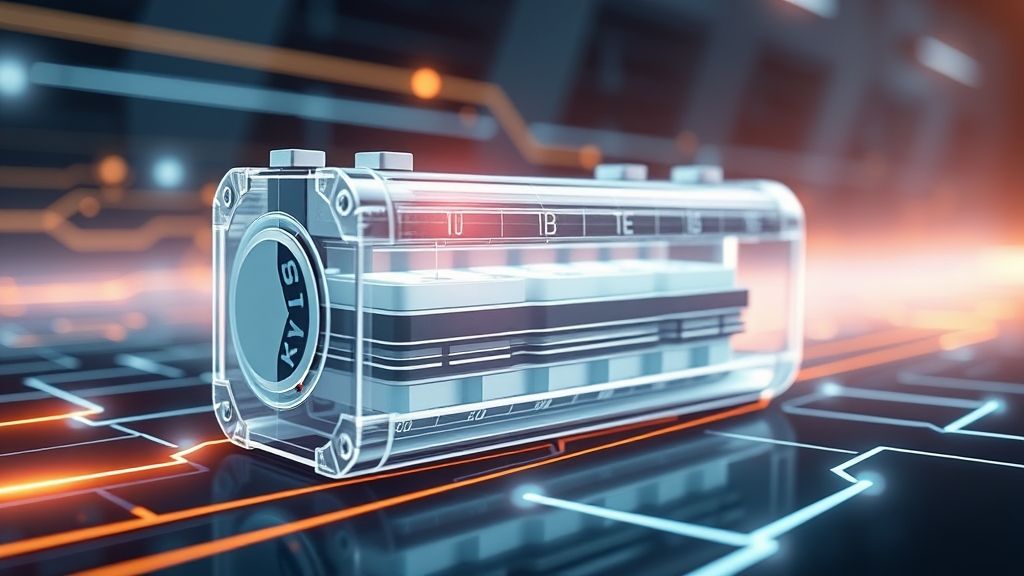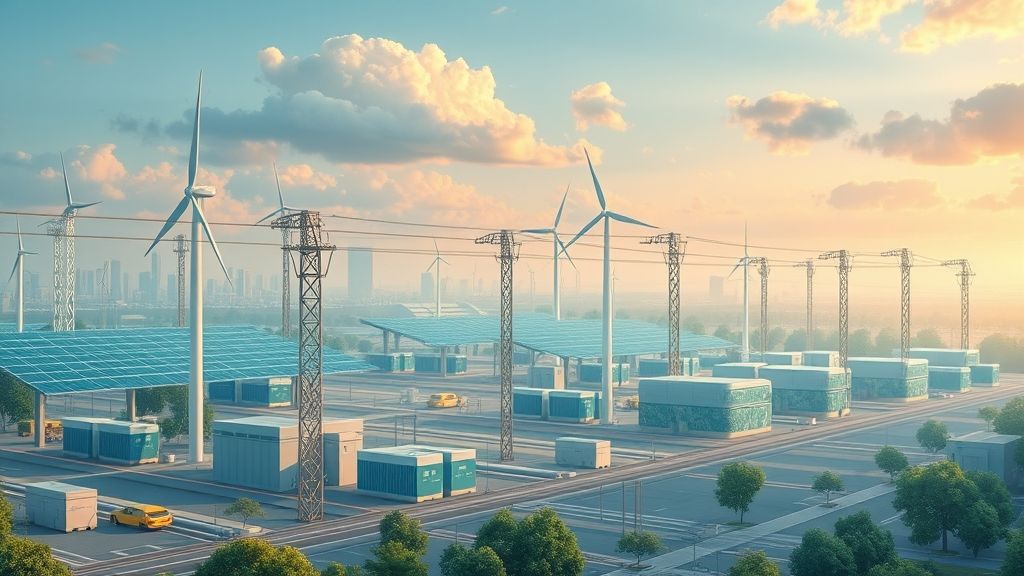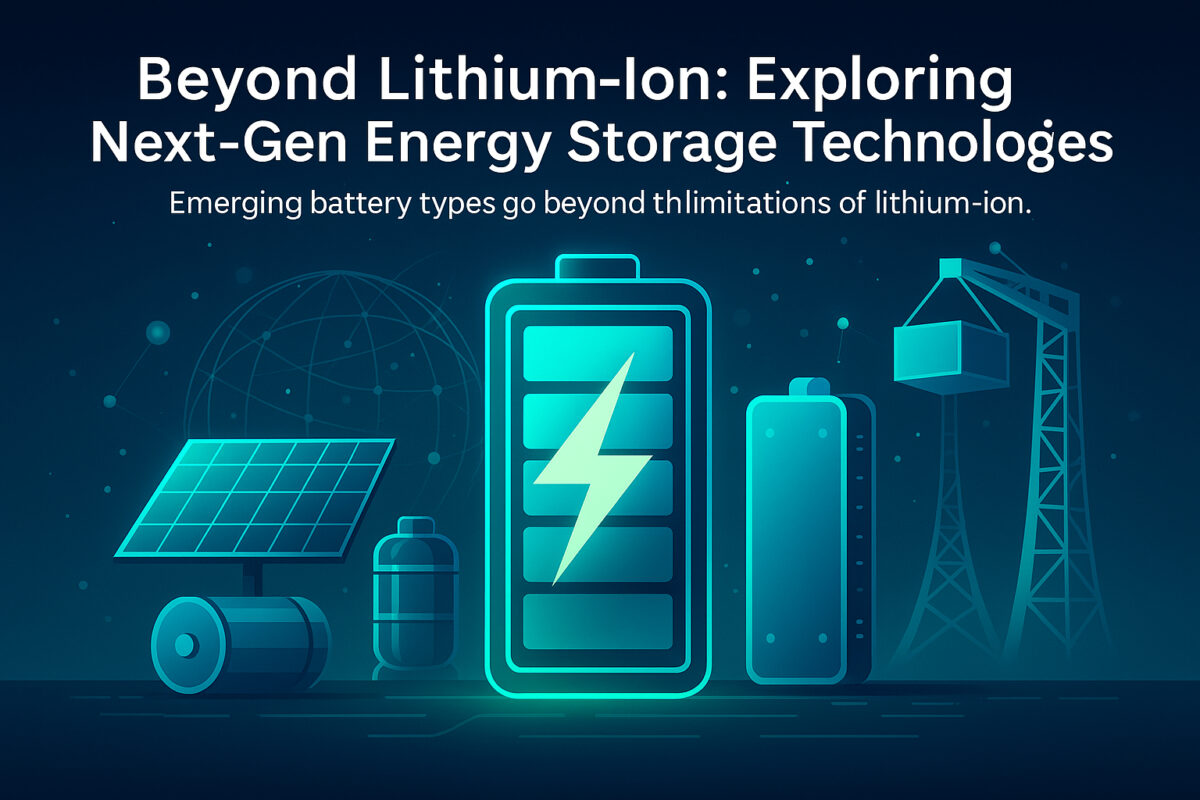As the world accelerates toward a clean energy future, the limitations of lithium-ion batteries are becoming increasingly clear. From material shortages and safety risks to environmental concerns and slow charging times — it’s evident that the future of energy storage must move beyond lithium-ion.
In this article, we explore 7 cutting-edge technologies that could reshape how we store and distribute energy. From solid-state batteries to hydrogen storage and gravity-powered systems, these innovations are more than just science fiction — they’re paving the way for a sustainable, efficient, and scalable energy ecosystem.
Table of Contents
1. The Lithium-Ion Bottleneck: Why We Need Alternatives
For decades, lithium-ion batteries have been the cornerstone of energy storage — powering smartphones, laptops, electric vehicles (EVs), and even grid systems. But as energy demands grow, so do the limitations of this aging technology.
⚠️ Key Challenges of Lithium-Ion Batteries:
- Material Scarcity & Supply Chain Risks
Lithium, cobalt, and nickel are concentrated in a few regions, leading to price volatility, political dependency, and environmental strain from mining operations. - Safety Hazards
Lithium-ion batteries are prone to thermal runaway, making them flammable or even explosive under certain conditions — a major concern in EVs and large-scale storage. - Environmental Impact
Mining and improper disposal of lithium-based cells contribute to water pollution, habitat destruction, and growing e-waste problems. - Charging & Degradation Issues
They offer limited fast-charging capabilities, and over time, their capacity degrades, requiring frequent replacement — not ideal for long-term or heavy-duty applications.
📌 Because of these bottlenecks, researchers and innovators worldwide are racing to build next-gen batteries that are cheaper, safer, cleaner, and more scalable.
Let’s now explore the most promising alternatives leading the charge 🚀
2. Solid-State Batteries: A Safer, Denser Future?
Among the top contenders for replacing lithium-ion, solid-state batteries stand out for their potential to revolutionize both consumer electronics and electric vehicles.
Unlike conventional batteries that use liquid electrolytes, solid-state batteries rely on solid ceramic, glass, or polymer electrolytes — a shift that brings significant advantages.
🚀 Key Benefits:
- Higher Energy Density
Solid-state batteries can store more energy in less space, which means longer-lasting devices and EVs with extended range. - Improved Safety
Without flammable liquid electrolytes, they’re far less prone to fire or explosion, even under stress or high temperatures. - Faster Charging
Some prototypes have demonstrated the ability to charge in minutes rather than hours — a game-changer for EV adoption. - Longevity & Stability
They offer a longer life cycle and minimal degradation, making them ideal for long-term use.
⚙️ Challenges Holding It Back:
- Manufacturing Scalability
Current production is expensive and difficult to scale. Companies are still struggling to produce solid-state batteries consistently at commercial volumes. - Material Limitations
Solid electrolytes have issues with interface stability, and dendrite formation still poses a threat to performance.
🧪 Major companies like Toyota, QuantumScape, and Samsung are investing heavily in solid-state tech, aiming for commercial rollouts by the late 2020s.
Solid-state batteries may soon become the gold standard, but they’re not the only game in town…

3. Flow Batteries: Scaling Up for Grid-Level Storage
Unlike lithium-ion or solid-state batteries, flow batteries operate more like a fuel cell: energy is stored in external tanks of liquid electrolytes, which “flow” through the battery cell during charge and discharge cycles.
This unique structure makes flow batteries especially suited for grid applications — not smartphones or EVs.
⚡ Why Flow Batteries Matter:
- Long Cycle Life
Flow batteries can withstand tens of thousands of charge-discharge cycles with minimal performance loss, making them highly durable. - Deep Discharge Capability
They can be completely discharged without damaging the battery — ideal for power backup and grid load balancing. - Modular Scalability
Want more capacity? Just install a larger tank — the energy and power components are decoupled, offering unmatched flexibility for scaling. - Lower Environmental Impact
Many flow batteries use non-toxic, abundant materials like vanadium or iron, reducing environmental and geopolitical concerns.
⚙️ Current Limitations:
- Size & Weight
Due to their external tanks and liquid-based system, flow batteries are bulky, which makes them impractical for mobile or small-scale use. - High Initial Cost
While the lifetime cost may be favorable, the upfront investment is still a barrier for broader deployment.
🌍 Countries like China and the U.S. are already piloting flow battery storage systems to support renewables like solar and wind.
These are batteries made for the grid, not your pocket — and that’s exactly where we need them.
4. Sodium-Ion Batteries: Abundance and Affordability
With lithium prices soaring and supply chains tightening, sodium-ion batteries are emerging as a cost-effective, resource-abundant, and scalable solution.
Sodium, the sixth most abundant element on Earth, is far easier to source than lithium — and it’s widely distributed across the globe, especially in sea salt and minerals.
🌊 Key Advantages of Sodium-Ion Batteries:
- Raw Material Abundance
Sodium is non-toxic, plentiful, and cheap — removing the bottlenecks associated with rare and expensive elements like lithium and cobalt. - Lower Production Costs
Because sodium-based materials are more common and simpler to extract, these batteries could be manufactured more cheaply, making them attractive for large-scale applications. - Safe & Stable
Sodium-ion batteries are generally less prone to overheating or fire, enhancing safety for storage and transport. - Temperature Tolerance
They perform better than lithium-ion in low-temperature environments, which is useful in certain climate zones and industrial settings.
⚙️ Drawbacks to Watch:
- Lower Energy Density
Sodium-ion batteries currently hold less energy per unit weight than lithium-ion, limiting their suitability for EVs and compact devices — for now. - Technology Maturity
Still in early commercial development, with companies like CATL and Natron Energy leading pilot production and real-world testing.
🔋 Sodium-ion batteries may not replace lithium overnight, but they’re on track to disrupt sectors like stationary energy storage, two-wheelers, and budget EVs.
5. Beyond Chemical Reactions: Emerging Storage Technologies
As the energy landscape evolves, researchers are exploring storage methods not based on traditional battery chemistry. These systems offer new ways to store renewable energy at scale — using gravity, heat, air, and even hydrogen.
Here’s a breakdown of some of the most exciting technologies on the horizon:
🪨 Gravity Batteries: Letting Nature Do the Heavy Lifting
Imagine storing energy by lifting massive weights when there’s excess power, and then releasing them to generate electricity when needed. This is the principle behind gravity batteries.
- No chemical degradation = Long lifespan
- Ideal for retired mines or tall structures
- Low maintenance, low fire risk
⛏️ Example: Energy Vault is already deploying gravity storage towers in Switzerland and China.
🔥 Thermal Energy Storage: Capturing Heat for Power
Thermal storage involves storing energy as heat — often using molten salts or heated bricks — and releasing it as electricity later.
- Useful in solar farms or industrial settings
- Highly efficient with proper insulation
- Can repurpose old power plants by replacing boilers
🌞 Example: CSP (Concentrated Solar Power) plants often store solar energy this way for nighttime use.
💨 Compressed Air Energy Storage (CAES): Air Under Pressure
CAES systems store energy by compressing air in underground caverns or tanks, then releasing it through turbines when power is needed.
- Great for large-scale, long-duration storage
- Less expensive materials than batteries
- Efficiency is improving with hybrid thermal integration
🌬️ Fun fact: CAES tech dates back to the 1970s — and is now getting a modern upgrade.
💧 Hydrogen Storage: Fuel of the Future?
Hydrogen can be produced using excess renewable electricity (via electrolysis) and stored for later use — either as fuel or reconverted into electricity.
- Stores energy for days to months, not just hours
- Powers everything from trucks to steel plants
- Infrastructure and safety are still being developed
🧪 Green hydrogen is especially promising as a zero-emission energy carrier for the future.
These technologies represent the next frontier in storage — each one with unique strengths tailored to specific grid, industrial, or long-term energy needs.
6. The Smart Grid Revolution: Integrating Diverse Storage Solutions
As we adopt a mix of energy sources — solar, wind, nuclear, hydrogen, and more — the electricity grid needs to evolve. Enter the smart grid: a digitally enhanced, automated, and flexible energy network built to optimize generation, distribution, and storage.
⚡ Why Smart Grids Matter
- They balance supply and demand in real-time
- Integrate a wide variety of storage systems
- Enable dynamic energy pricing
- Improve grid reliability and efficiency
- Reduce energy waste through predictive analytics
🧠 Role of AI & Data in Energy Storage Optimization
Artificial Intelligence and machine learning help make smart grids truly smart by:
- Predicting energy demand using weather and usage data
- Optimizing battery performance and charging cycles
- Identifying the best storage type based on grid needs
- Minimizing energy loss and cost via intelligent routing
🧠 Example: AI can decide whether to pull from gravity batteries, sodium-ion systems, or hydrogen storage depending on cost, urgency, and efficiency.
🧩 Hybrid Storage: Matching Tech to Use-Case
Smart grids allow different storage systems to work in harmony:
| Storage Type | Best Use Case |
|---|---|
| Lithium-Ion | EVs, residential energy storage |
| Solid-State | Premium EVs, mobile electronics |
| Flow Batteries | Grid-scale energy shifting |
| Sodium-Ion | Budget EVs, stationary storage |
| Gravity / CAES | Long-duration, grid backup |
| Thermal / Hydrogen | Industrial, seasonal, long-term |
This combinatorial approach is key to resilience and flexibility in tomorrow’s energy networks.
🛠️ Smart Grid Infrastructure: The Backbone
To make this all work, infrastructure needs to be modernized:
- Smart meters in homes and businesses
- IoT sensors for real-time performance tracking
- Decentralized energy generation (solar rooftops, local wind farms)
- Bidirectional flows so energy can move both ways
🔌 Bottom line: The smart grid is not just an upgrade — it’s the platform that unlocks the full potential of advanced energy storage.

7. The Economic and Environmental Impact: A Sustainable Energy Future
Advanced energy storage is more than a technical innovation — it’s a cornerstone for a sustainable, resilient, and equitable energy system.
🌍 Environmental Gains
- Reduced dependence on fossil fuels by storing renewable energy.
- Lower carbon footprint with eco-friendlier alternatives (e.g., sodium-ion, gravity, and flow batteries).
- Minimizing toxic waste from mining and discarded lithium-ion batteries.
- Support for circular economy with recyclable and reusable battery components.
🟢 For example: Flow batteries use vanadium or iron solutions that can be reused almost indefinitely.
💸 Economic Opportunities
- Boost in green jobs: engineers, AI specialists, grid managers, and battery technicians.
- Support for localized energy production, reducing reliance on foreign resources.
- Lower electricity bills through smart-grid optimization and dynamic pricing.
- Enabling energy access in remote or underserved communities with scalable microgrids.
💰 Solid-state and sodium-ion batteries, once mass-produced, are projected to significantly reduce costs in the EV and residential storage markets.
🚗 EV Acceleration & Grid Resilience
- Next-gen batteries can extend EV range, reduce charging times, and lower ownership costs.
- With efficient storage, renewables become viable 24/7 sources.
- Enhances energy security, especially in disaster-prone or geopolitically unstable regions.
🔄 Long-Term Vision: Energy Abundance
The fusion of:
- Innovative storage tech,
- Smart grid integration, and
- AI-driven optimization
…positions us for a post-carbon energy future, where clean energy is not just sustainable — it’s reliable, cheap, and universal.
Conclusion: Powering the Future, One Innovation at a Time
As we move beyond the limitations of lithium-ion batteries, a new era of energy storage technology is emerging—driven by solid-state breakthroughs, scalable grid solutions, and smart integrations. From sodium-ion to gravity-based systems, these innovations promise not just better performance, but a more sustainable and resilient energy future. The evolution of storage is more than a technical shift—it’s a cornerstone of global progress. Staying informed and supporting these advancements will shape the way we power our homes, our cities, and our planet.
💬 Which feature excites you the most? Comment below!
💡 Stay ahead of the future! Follow us on:
Facebook | LinkedIn


